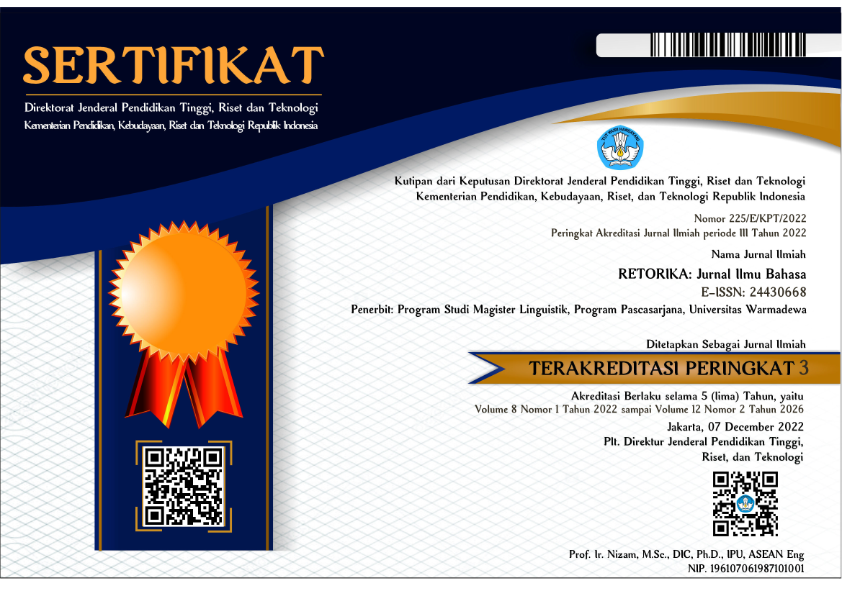The Human Beings’ Submissiveness to Supernatural Beings in Folktales from Central Sulawesi
Abstract
Indonesia is an archipelagic nation of thousands of islands with vast and diverse cultures. Every inhabited island must have at least a culture comprising cultural products such as rites, tales, ceremonies, etc. However, some individual islands might also have more than one culture. The culture carries sets of beliefs that are worth examining to understand and cultivate the people’s worldviews and perspectives. Those perspectives can be traced from folktales as cultural products. As the agent in the Anthropocene period, human beings are also observable in the generationally told folktales. This article explores the depictions and the roles of human characters and supernatural beings in two folktales from Sulawesi, one of the biggest islands in Indonesia. It problematizes the independency and power of human beings in the folktales. The research objects of this article are The Giant and the Orphan (Kalamboro Kaa Elu-elu) and People Who Descended (Miantii). By employing appraisal theory (Martin and White, 2005), this article identifies the attitudes towards both human and supernatural characters by the linguistic choices attached to them in the folktales. The choices of words and expressions depicting the characters are classified into affect, judgement, and appreciation. In conjunction with the folktales’ plot, the linguistic analysis reveals that human characters in those two folktales are depicted as dependent on and powerless before supernatural characters. This article does not intend to draw any generalization toward any cultures from Sulawesi and Indonesia since it examines very limited objects.
References
Andersen, T. D. (Ed.). (1999). Cerita rakyat Sulawesi Tengah. Yogyakara: Kanisius.
Arafah, N., & Ma’ruf, A. (2015). The adaptation of local wisdom as a solution to environmental conservation in small islands. Proceedings of the Celebes International Conference on Diversity at Wallacea’s Line (CICWDL) (pp. 459-464). Kendari: Unhalu Press.
Bassano, C., Barile, S., Piciocchi, P., Spohrer, J. C., Iandolo, F., & Fisk, R. (2019). Storytelling about places: Tourism marketing in the digital age. Cities, 87, 10-20. doi:10.1016/j.cities.2018.12.025
Druce, S. C. (2016). Transmitting the past in South Sulawesi: The Hikajat Sawitto and other Bugis and Makasar historical works. International Journal of Asia Pacific Studies, 12(1), 73-117. doi:http://dx.doi.org/10.21315/ijaps2016.12.s1.5
Forshee, J. (2006). Culture and customs of Indonesia. Wesport: Greenwood Press.
Ironside, R., & Massie, S. (2020). The Folklore-centric gaze: a relational approach to landscape, folklore and tourism. Time and Mind, 25(3), 1-18. doi:10.1080/1751696X.2020.1809862
Kim, S. J., Song, A., Lee, G.-L., & Bach, A. (2018). Using animated folktales to teach cultural values: A case study with Korean-American bilingual kindergartners. Journal of Research in Childhood Education, 32(3), 295-309. doi:10.1080/02568543.2018.1464528
Larobu, S. (1999). Miantii. In T. D. Andersen (Ed.), Cerita rakyat Sulawesi Tengah (pp. 116-126). Yogyakarta: Kanisius.
Lewin, D. (2020). Between horror and boredom: Fairy tales and moral education. Ethics and Education, 15(2), 213-231. doi:10.1080/17449642.2020.1731107
Lwin, S. M., & Marlina, R. (2018). Using folktales as a way to operationalise the paradigm of teaching English as an international language. Asian Englishes, 20(3). doi:https://doi.org/10.1080/13488678.2018.1440279
Martin, J. R., & White, P. R. (2005). The language of evaluation. New York: Palgrave.
Martin, J. R., & Rose, D. (2007). Working with discourse. London: Continuum.
Maulana, A., & Benita, T. (2017). Typologi of island city in Indonesia. IOP Conference Series: Earth and Environmental Science. 79. IOP Publishing.
Muliadi, Amin, K. F., & Mansyur, U. (2020). Pelatihan penulisan naskah drama dari cerita lisan Sulawesi Selatan di MTs Negeri 2 Biringkanaya Makassar. Jurnal Abdimas BSI, 3(2), 127-132. doi:https://doi.org/10.31294/jabdimas.v3i2.7064
Nnyagu, U., & Umezinwa, R. N. (2018). Folktale as a tool for character development. African Research Review, 12(3), 92-98. doi:10.4314/afrrev.v12i3.10
Sinampu, L. (1999). Kalambo Kaa Elu-Elu. In T. D. Andersen (Ed.), Cerita rakyat Sulawesi Tengah (pp. 111-115). Yogyakarta: Kanisius.
Small, J. (2019). Doing theatre: Theater pedagogy through the folktale. Cultural and Pedagogical Inquiry, 11(3), 80-91. doi:https://doi.org/10.18733/cpi29505
Sone, E. M. (2018). The folktale and social values in traditional Africa. Eastern African Literary and Cultural Studies, 4(2), 142-159. doi:10.1080/23277408.2018.1485314
The Indonesian National Oceanographic Data Center. (n.d.). Statistic. Retrieved September 12, 2022, from The Indonesian National Oceanographic Data Center: https://nodc.id/statistik
Thompson, S. (2004). The child, the Family, the relationship. Familiar stories: Family, storytelling, and ideology in Philip Pullman’s His dark materials. In K. Lesnik-Oberstein (Ed.), Children’s literature new approach (p. 144). New York: Palgrave Macmillan.
Verdonk, P. (2002). Stylistics. Oxford: Oxford University Press.
White, D. R. (1998). A century of Welsh myth in children literature. London: Greenwood Press.
Zipes, J. (2006). Fairy tales and the art of subversion. New York: Routledge.
Copyright (c) 2023 RETORIKA: Jurnal Ilmu Bahasa

This work is licensed under a Creative Commons Attribution-ShareAlike 4.0 International License.
This journal provides immediate open access to its content on the principle that making research freely available to the public supports a greater global exchange of knowledge.
All articles published Open Access will be immediately and permanently free for everyone to read and download. We are continuously working with our author communities to select the best choice of license options, currently being defined for this journal as follows: Creative Commons-Non Ceomercial-Attribution-ShareAlike (CC BY-NC-SA)
 Abstract viewed = 69 times
Abstract viewed = 69 times
 PDF downloaded = 82 times
PDF downloaded = 82 times

2.png)














